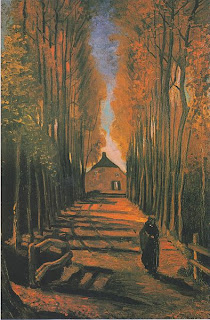Roy Lichtenstein was one of the most
famous and influential figures of the American pop art movement, and you can
see a large portion of his work at a special exhibition at the Tate Modern Museum. Lichtenstein defined the premise of pop art through his use of parody,
which is reflected in his homages and recreations of famous art styles and
paintings. He is perhaps most well known for his concept of painting inspired
by comic strips, advertising, and mass/pop culture imagery. The exhibition is
organized in a way that places the focus on Lichtenstein's art; the white walls
and categorized rooms allow you to easily navigate his work and see his
progression in style. Lichtenstein's paintings varied from his take on
brushstrokes, to pop art featuring pop culture figures like Mickey Mouse, to
black and white images, and to Chinese-inspired landscapes. This is a
fascinating and surprisingly in-depth exhibition that is well worth the entry
fee.
 |
| Look Mickey, Lichtenstein |
Lichtenstein was known for
referencing other forms of art in his work and through his parodies almost
deconstructing the art form itself. For example, his series of brushstroke
paintings are seen as parodies of abstract expressionism that were popular in
American art in the 1950's. Whereas other artists such as Jackson Pollock
sought to present their brushstrokes as impulsive, Lichtenstein showed the
brushstroke as the result of a carefully controlled act. His paintings in this
series are also a prime example of how color and perspective can be used in
abstract expressionism to create different images. Lichtenstein's early
paintings in room 2 showcase his early foray into paintings' featuring cartoon
imagery and a comic-book style aesthetic. His 1961 painting Look Mickey
was an artistic breakthrough for him, as it set the precedent for his future
pop art paintings. Lichtenstein would mimic popular art while applying his own
aesthetic and formal order to his paintings. Writing of pop art and
Lichtenstein, the critic Roland Barthes said “There are two voices, as in a
fugue. One says 'This is not Art'; the other says, at the same time, 'I am
Art.'” This quote serves as an accurate description of Lichtenstein's art, as
at first glance it appears to be nothing more than homage and pop culture
pastiche, but when you look closer you see that it also provokes emotion in you
and reflects the Lichtenstein's own artistic sensibilities.
 |
| Brushstroke, Lichtenstein |
Lichtenstein's work on landscapes
and seascapes are unique in how they bare down the elements of the sea and sky
to a series of horizontal lines and pointillism inspired circles. The result is
a series of almost abstract representations of landscapes. A couple of my
favorites from this section include Sea Shore and Sunrise. Both
paintings exhibit the features that would come to define his landscape work:
bright, contrasting colors, many circles forming the background, and a
comic-book aesthetic. This comic-book look would apply to the rest of his art
styles, and you can see how he mixes his style with the artists of the past he
admires. Lichtenstein himself stated that “the things that I have apparently
parodied I actually admire.” His appreciation for these works is seen in his
interpretations of famous works, where he applies his pop aesthetic to
traditionally high-art pieces, challenging views of what is art and what is
simply “low-art” parody. For example, Lichtenstein's 1963 painting Femme
d'Alger transforms Picasso's 1955 painting Women of Algiers into an
abstract piece of pop art. The original qualities that made Picasso's piece so
unique remain intact, yet Lichtenstein is also able to give the painting new
life through his take on the piece. This parody of traditional art forms is
also seen in Lichtenstein's interpretations of the nude. His painting Blue
Nude shows how he applies a pulpy, erotic appeal to what is traditionally
seen as a noble art form. At the same time, the piece remains a beautiful
painting as well. The starkness of the woman's features such as her bright
green eyes, blonde hair, and red lips contrast with the dullness of her pale,
white body. The final room features perhaps the biggest departure in
Lichtenstein's traditional style, as he chose to spend his final years painting
Chinese landscapes which were inspired by the simplicity of Chinese art.
Paintings such as Landscape with Philosopher and Landscape with Boat
retain his pointillism inspired backgrounds while introducing images that
recall traditional Chinese calligraphy and floral imagery. By the end of the
exhibition, you will have seen a wide variety of art that reflects the artist
Lichtenstein, whose singular passion for art is represented by all the images
you will see.
 |
| Lichtenstein Exhibition, Tate Modern |
Although pop art incites a decisive
reaction amongst people, the Lichtenstein exhibition is truly a defining series
of paintings that showcases the pinnacle of achievement in the field. Asking
people around the exhibition, I got responses from “this is fascinating” and
“thought-provoking” to less enthusiastic ones where people relayed an inability
to connect to the art or feel anything from it. However, I think if you spend
some time here you will see that this art does provoke a response in you, and
the exhibition features some of the most interesting art you will see at the
Tate Modern.
-By Phillip Storm, Arts
Correspondent, VisitMuseums.com
































